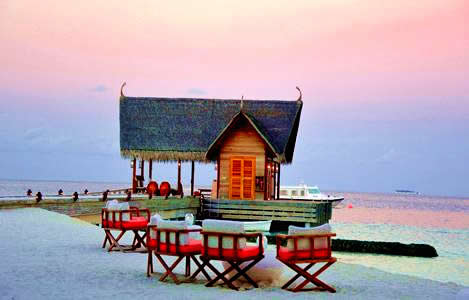|
Ready for a sprat? An impostor? 
Photograph
by Preeti Verma Lal
"Ready for a Blenny? A Sprat? An Imposter?” I was standing on the deck of Constance Halaveli’s TGI Dive Centre when Dive Master Tobias Titze’s question threw me off the jetty. An Imposter? No. A Sprat? Naah. I wasn’t even sure who/what they were. In the Dive Centre, I certainly was not in search of an Imposter. Not in Halaveli in Maldives’s North Ari Atoll, often touted as one of the best dive sites in the world.
But why was there so much baloney over a blenny? I was still befuddled when Titze began the basic dive lesson. Okay, the answers first. Of the 1,200 species of fish recorded in Maldives, blenny, the bottom-dwelling grazer, is one of the commonest. And the Imposter? Well, he actually is an imposter fish. It has no venom, yet it mimics the poisonous Smith’s Sabretooth Blenny. And when you wriggle into the black wet suit, strap nearly 20-kg of equipment and dive off the boat into the turquoise waters, the blennys and the imposters will be all around you, flapping their fins as you hold the breath and swim with the anemones and shoals of fish deep into the ocean’s belly.
Sitting on a black plastic chair, with wet suits dangling all around me, I was getting greedy. “Will I find a pearl?” Titze was amused at my greed. “Will you settle for a reef shark, instead?” The German dive master was offering options. “A shark?” I baulked. As if one shark wasn’t intimidating enough, there are 40 different types of sharks in Maldives. Adding to my diving fear factor were the stingrays that come with barbed stings and mantas that can stretch 22 ft wing tip to wing tip and weigh up to 1,350 kgs.
With each frightening fish name, I was shedding the idea of diving. Let me confess: I am a tardy swimmer and have never taken a breath underwater. Diving seemed daunting and dangerous, but in Halaveli Constance, I could not hang my boots (read: flippers) so easily. Diving surely was not as easy taking a dhoni (traditional Maldivian boat), sailing 30 minutes on the placid water to Maya Thila (one of the best dive sites in Halaveli) and jumping off.
No. Not that easy. I’d have to do the Open Water Diver’s Course, a beginner’s certification course by Professional Association of Diving Instructors (PADI), the world’s largest recreational diving membership and diver training organization. Like a schoolgirl, I’ll have to learn the diving lingo: ‘cricket’ is not a game but a lobster below the legal size; ‘cluster%^&*’ is complete pandemonium; ‘OOA’ is out of air and ‘pretzel’ is bent in agony… And I, the tardy swimmer and never-a-diver, a ‘newbie’.
Feeling like a sedulous schoolgirl hunched over her homework, I wondered if the dive lingo was enough to pick my pearl from the deep ocean. No. I’d first need to fix the mask, fins and snorkel; swim 300 metres and float for 10 minutes to demonstrate waterskill comfort. Of course, I’d have to complete a questionnaire about medical condition: Not pregnant. No asthma. No respiratory complications. No water allergies.
I quickly said no to all medical questions. But after all this, will I pick the pearl? No pearl. In his 8,000 dives, Titze has never picked a pearl; I sure could not find it in my first dive. I was no Japanese pearl diver who dives without oxygen cylinders – they can hold their breath for 6 minutes. Six minutes? My best held-breath is 30 seconds! I cannot even dive too deep. In Maldives, the dive depth limit is 30 metres. I did not fume over the depth limit; I knew I was safe in the Maldivian waters – Maldivian diving sites have recorded the least number of accidents per 10,000 dives anywhere in the world.
Before I could slip into the wet suit, I was distracted. In the Constance Halaveli TGI Dive Centre, all around lay corals – soft, pearly white corals, red coral with symmetrical slits, stony corals, finger coral the size of fries, rubbly limestone made of petrified coral… Sadly, the corals are dying in Maldives , the world’s most low-lying nation. In the past 15 years, the temperature and water levels have been rising menacingly and the nation is sinking helplessly. Naysayers predict that by the turn of the century, Maldives would vanish off the map – it would be buried in the turquoise waters.
The thought of the beautiful nation meeting its watery grave perturbed me and I forgot all diving; I’d rather plant a coral garden. And all this while I thought only lilac, lilies, lavender and laburnum grew in gardens. Ah! I am so ignorant. Yes, coral fragments can be planted on cement blocks to let baby corals grow into burly reefs in the tepid water. Or, I could throw an iron lattice into the waters so that corals can grow. I forgot about diving and obsessed about corals. After all, corals are so essential for the survival of Maldives .
That evening in Constance Halaveli, I stood by the jetty looking at the coral lattice lying languorously in the ocean. Without the corals, Maldives will vanish off the map. Diving can wait for another day. In Maldives, I’d plant the coral garden first.
The Crest Edition, September, 2012
|

